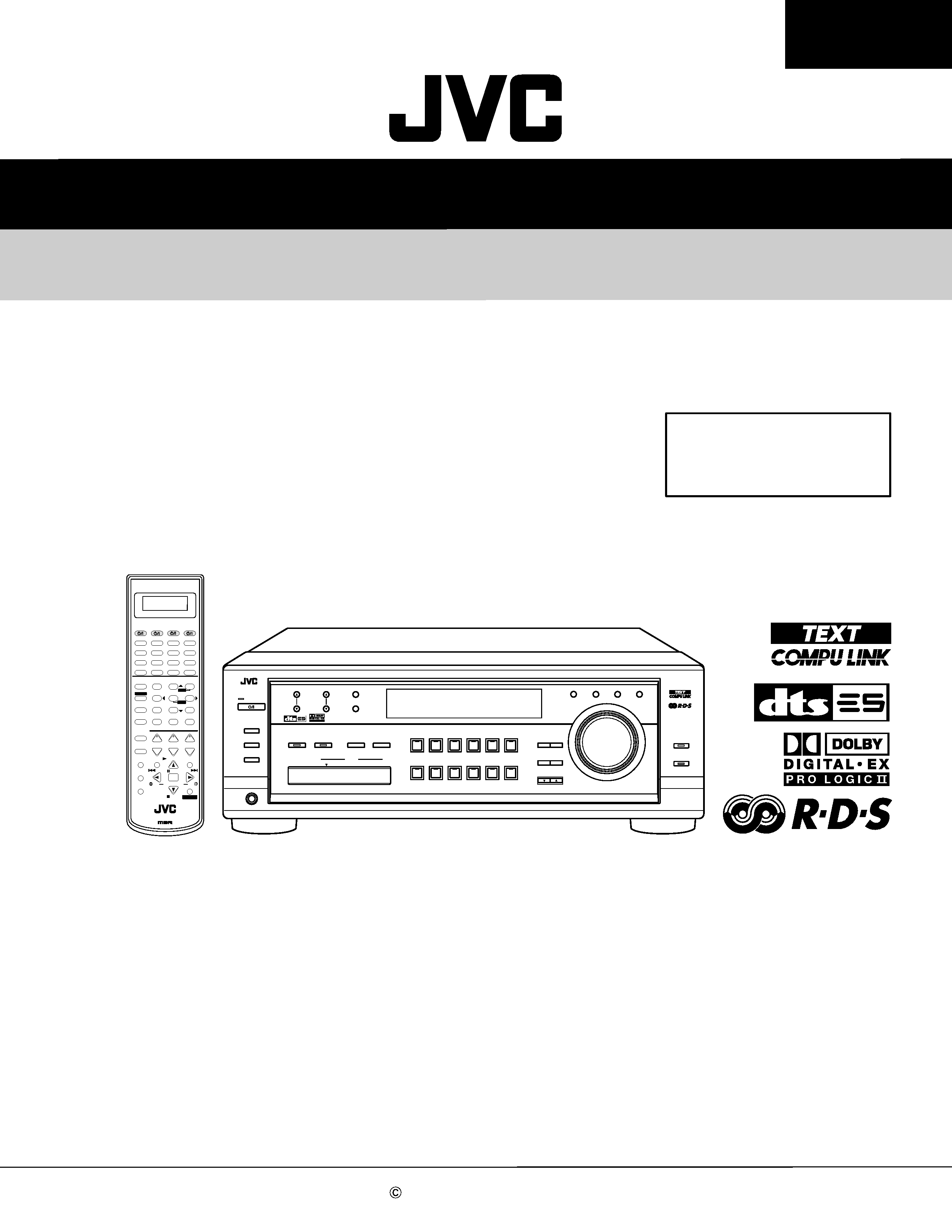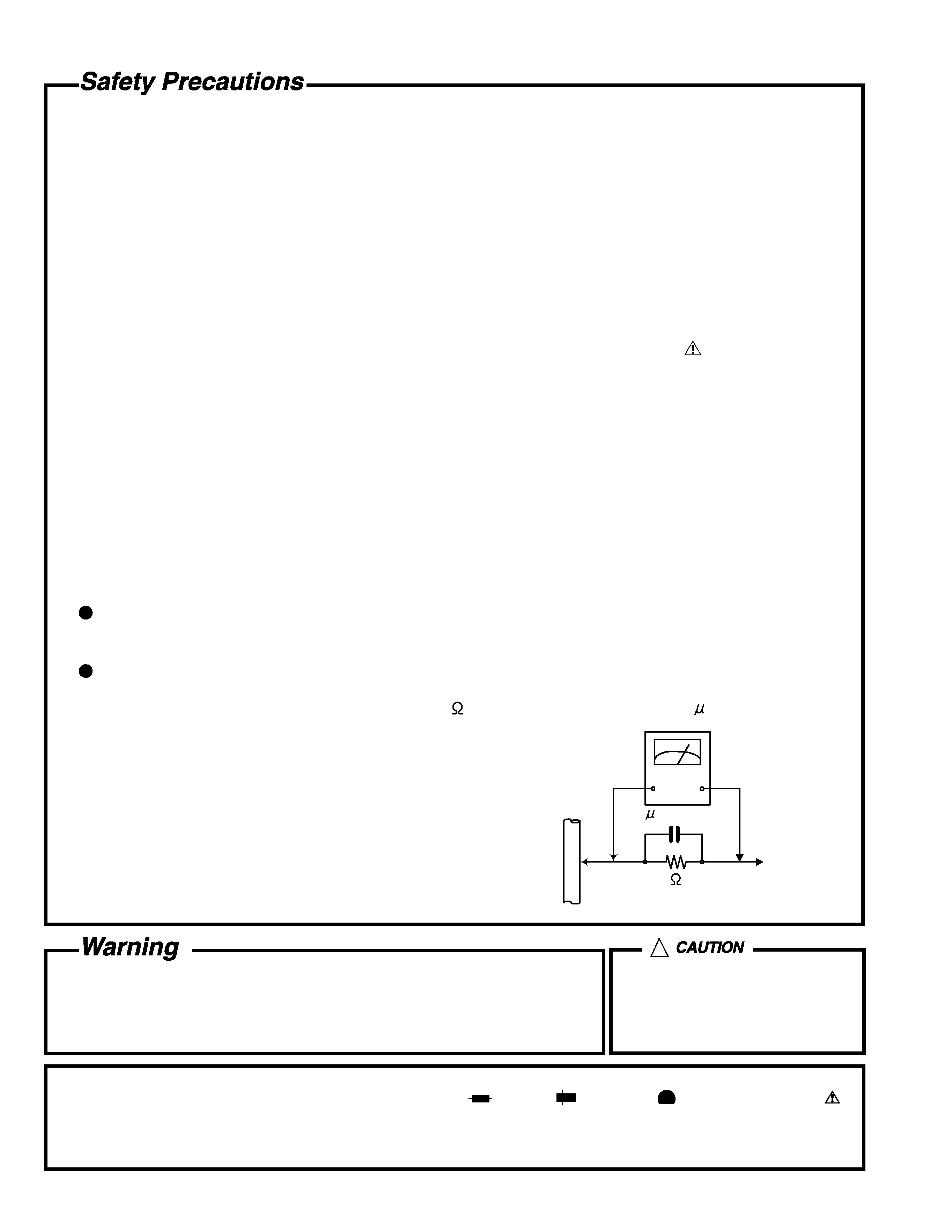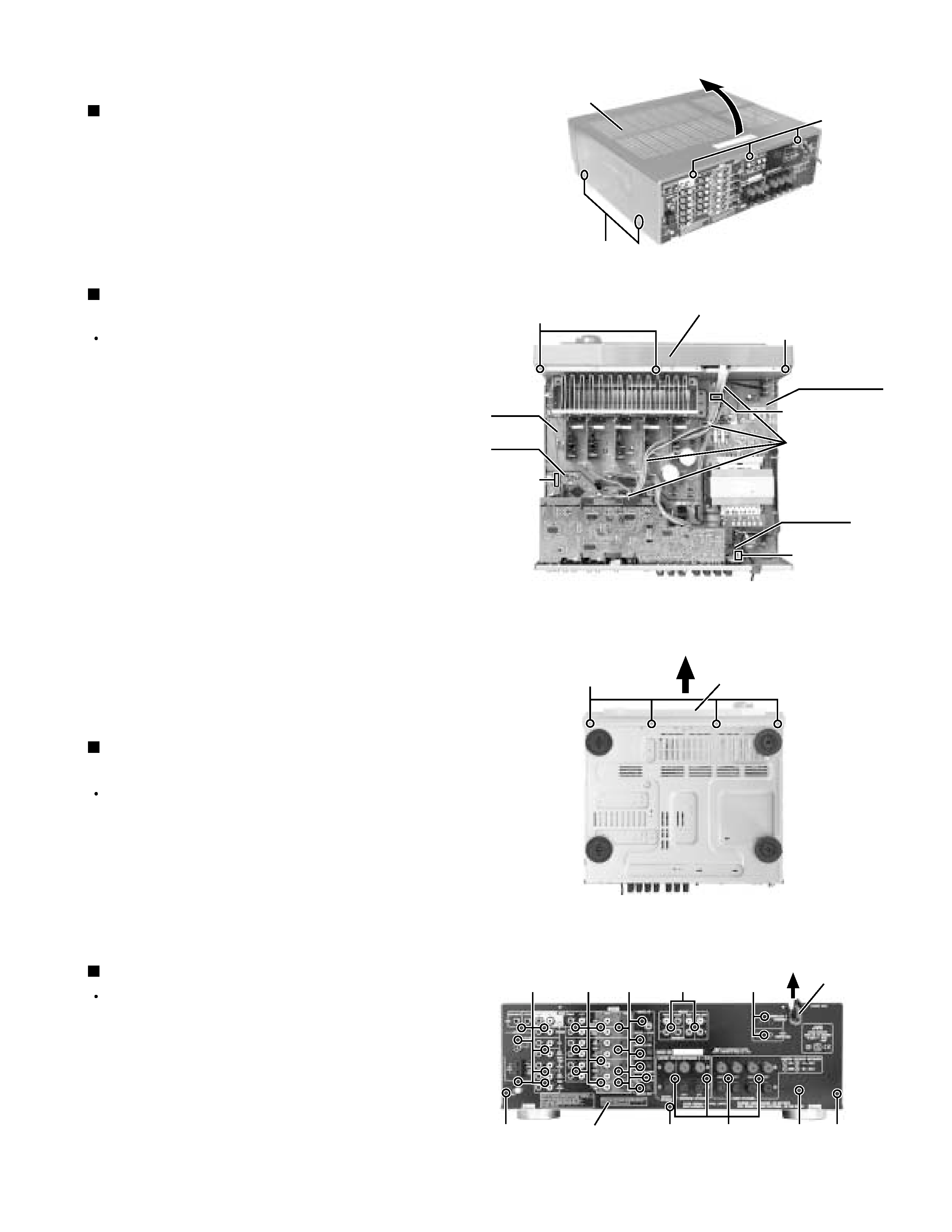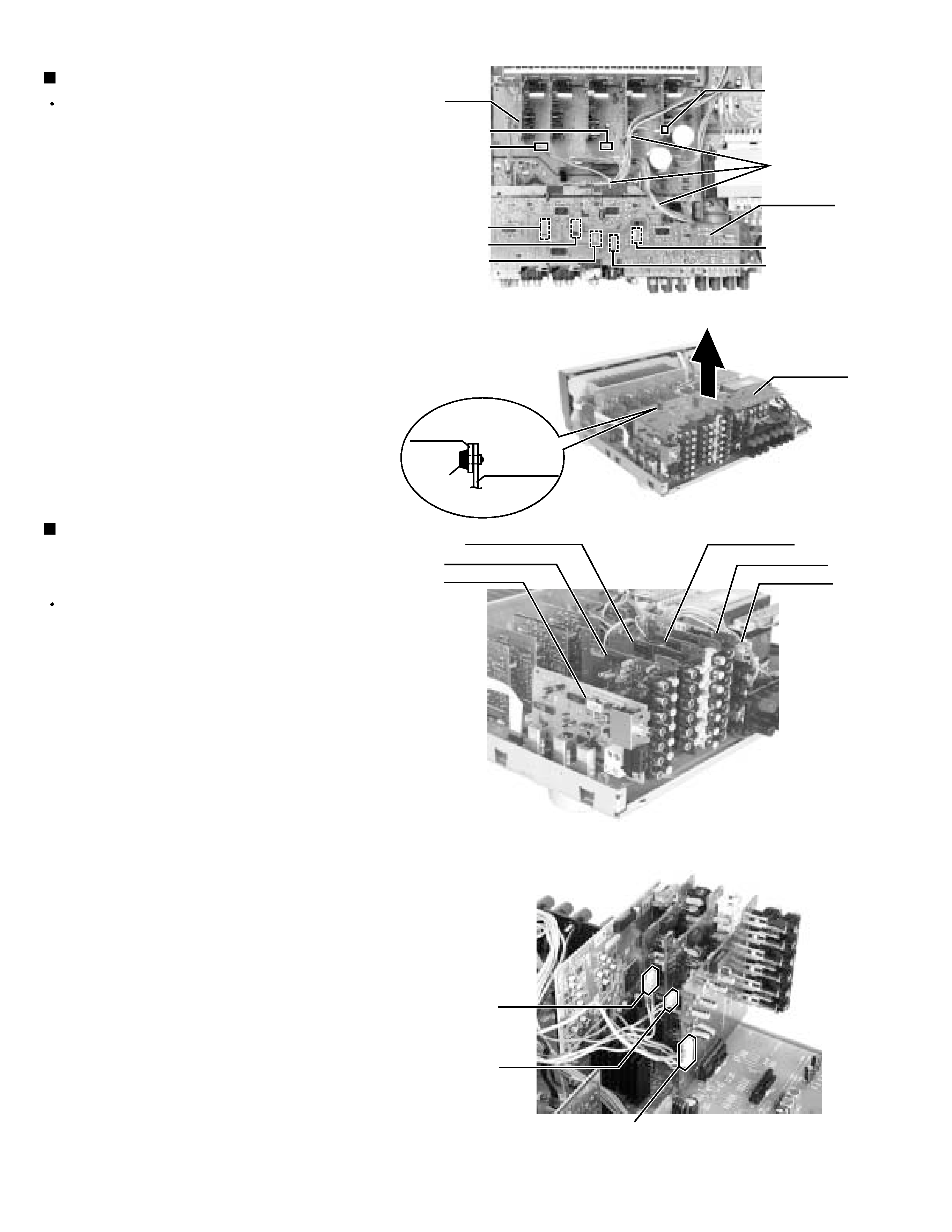
SERVICE MANUAL
AUDIO/VIDEO CONTROL RECEIVER
No.21144
Sep. 2002
COPYRIGHT
2002 VICTOR COMPANY OF JAPAN, LTD.
RX-8022RSL
RX-8022RSL
Contents
Safety precautions --------------------------------------------------------1-2
Disassembly method -----------------------------------------------------1-3
Adjustment method -------------------------------------------------------1-9
Self-diagnose function-----------------------------------------------------1-10
Description of major ICs -------------------------------------------------1-12~30
Area suffix
E --- Continental Europe
EN ---- Northern Europe
MENU
23
1
56
4
89
7/P
0
+10
10
BOOST
FRONT¥L
MENU
ENTER
FRONT¥R
BASS
DIMMER
TEST
CENTER
SUBWFR
DIGITALEQ
SBACK¥L
SBACK¥R
SURR¥L
SURR¥R
MUTING
CH/ LEVEL TV VOL
PLAY
STOP
/REW
PTY
FF/
EXIT
VOLUME
CATV/DBS
CONTROL
TV/VIDEO
REC
PAUSE
SLEEP
PAUSE
SET
RETURN
FMMODE
100+
CONTROL
CATV/DBS
VCR1
TV
AUDIO
DSP
OFF
DVD MULTI
DVD
USB
CD
CDR
TAPE/MD
TV/DBS
VIDEO
PHONO
FM/AM
VCR1
VCR 2
SURROUND
SURR/DSP ANALOG/DIGITAL
A/V CONTROL RECEIVER
INPUT
DIRECT
ANALOG
TEXT
DISPLAY
SOUND
TA/NEWS/
INFO
DISPLAYMODE
PTY SEARCH
PTY
CONTROL
DOWN
UP
EFFECT SETTING
DIGITAL
EQ
TV SOUND/DBS
VIDEO
VCR 2
VCR 1
DVD
DVD MULTI
INPUT
ANALOG / DIGITAL
DSP
S-VIDEO
VIDEO
VIDEO
LÑ AUDIOÑ R
SURROUND
SUBWOOFER OUT ON/OFF
SPEAKERS ON/OFF
FM/AM TUNING
FM/AM PRESET
FM MODE
MEMORY
PHONES
1
STANDBY
USB AUDIO
SURROUND / DSP
OFF
FM/AM
USB AUDIO
TAPE/MD
CDR
CD
PHONO
LEVEL
ADJUST
AUDIO/VIDEO CONTROL RECEIVER
ANALOG DIRECT
BASS BOOST
MASTER VOLUME
2
SOURCE NAME
SOUCE NAME
STANDBY/ON
INPUT ATT
PUSH OPEN
PTY SEARCH
TA / NEWS / INFO
DISPLAY MODE
DIMMER

RX-8022RSL
1-2
1. This design of this product contains special hardware and many circuits and components specially for safety
purposes. For continued protection, no changes should be made to the original design unless authorized in
writing by the manufacturer. Replacement parts must be identical to those used in the original circuits. Services
should be performed by qualified personnel only.
2. Alterations of the design or circuitry of the product should not be made. Any design alterations of the product
should not be made. Any design alterations or additions will void the manufacturer`s warranty and will further
relieve the manufacture of responsibility for personal injury or property damage resulting therefrom.
3. Many electrical and mechanical parts in the products have special safety-related characteristics. These
characteristics are often not evident from visual inspection nor can the protection afforded by them necessarily
be obtained by using replacement components rated for higher voltage, wattage, etc. Replacement parts which
have these special safety characteristics are identified in the Parts List of Service Manual. Electrical
components having such features are identified by shading on the schematics and by (
) on the Parts List in
the Service Manual. The use of a substitute replacement which does not have the same safety characteristics
as the recommended replacement parts shown in the Parts List of Service Manual may create shock, fire, or
other hazards.
4. The leads in the products are routed and dressed with ties, clamps, tubings, barriers and the like to be
separated from live parts, high temperature parts, moving parts and/or sharp edges for the prevention of
electric shock and fire hazard. When service is required, the original lead routing and dress should be
observed, and it should be confirmed that they have been returned to normal, after re-assembling.
5. Leakage currnet check (Electrical shock hazard testing)
After re-assembling the product, always perform an isolation check on the exposed metal parts of the product
(antenna terminals, knobs, metal cabinet, screw heads, headphone jack, control shafts, etc.) to be sure the
product is safe to operate without danger of electrical shock.
Do not use a line isolation transformer during this check.
Plug the AC line cord directly into the AC outlet. Using a "Leakage Current Tester", measure the leakage
current from each exposed metal parts of the cabinet, particularly any exposed metal part having a return
path to the chassis, to a known good earth ground. Any leakage current must not exceed 0.5mA AC (r.m.s.).
Alternate check method
Plug the AC line cord directly into the AC outlet. Use an AC voltmeter having, 1,000 ohms per volt or more
sensitivity in the following manner. Connect a 1,500
10W resistor paralleled by a 0.15 F AC-type capacitor
between an exposed metal part and a known good earth ground.
Measure the AC voltage across the resistor with the AC
voltmeter.
Move the resistor connection to each exposed metal part,
particularly any exposed metal part having a return path to
the chassis, and meausre the AC voltage across the resistor.
Now, reverse the plug in the AC outlet and repeat each
measurement. Voltage measured any must not exceed 0.75 V
AC (r.m.s.). This corresponds to 0.5 mA AC (r.m.s.).
1. This equipment has been designed and manufactured to meet international safety standards.
2. It is the legal responsibility of the repairer to ensure that these safety standards are maintained.
3. Repairs must be made in accordance with the relevant safety standards.
4. It is essential that safety critical components are replaced by approved parts.
5. If mains voltage selector is provided, check setting for local voltage.
Good earth ground
Place this
probe on
each exposed
metal part.
AC VOLTMETER
(Having 1000
ohms/volts,
or more sensitivity)
1500
10W
0.15 F AC TYPE
!
Burrs formed during molding may
be left over on some parts of the
chassis. Therefore, pay attention to
such burrs in the case of
preforming repair of this system.
In regard with component parts appearing on the silk-screen printed side (parts side) of the PWB diagrams, the
parts that are printed over with black such as the resistor (
), diode (
) and ICP (
) or identified by the " "
mark nearby are critical for safety.
(This regulation does not correspond to J and C version.)

1-3
RX-8022RSL
Remove the four screws A attaching the top cover
on both sides of the body.
Remove the three screws B on the back of the body.
Remove the top cover from behind in the direction of
the arrow while pulling both sides outward.
1.
2.
3.
Disassembly method
Removing the top cover (See Fig.1)
Prior to performing the following procedure, remove
the top cover.
Remove the power cord stopper from the rear panel
by moving it in the direction of the arrow.
Remove the thirty two screws E & F & G attaching
the each board to the rear panel.
Remove the three screws H attaching the rear panel
on the back of the body.
1.
2.
3.
Removing the rear panel
(See Fig.4)
Prior to performing the following procedure, remove
the top cover.
Cut off the tie bands.
Disconnect the harness from the connector CN416
(on the video audio board), CN206 (on the video
board) and CN244 (on the S video board) (see fig.8).
Disconnect the card wire from the connector CN400
on the audio board and CN402 on the power supply
board.
Remove the three screws C fixing the upper surface
of the front panel assembly, and four screws D fixing
the bottom.
Detach the front panel assembly toward the front.
Remove the screw X attaching the earth wire (see fig.
19).
1.
2.
3.
4.
5.
6.
Removing the front panel assembly
(See Fig.2 and 3)
Prior to performing the following procedure, remove
the top cover.
Disconnect the harness from the connector CN393
on the compu link board.
Remove the two screws E attaching the compu link
board to the rear panel.
1.
2.
Removing the compulink board
(See Fig.2 and 4)
Fig.1
Fig.2
Fig.3
Fig.4
A(both sides)
B
Top cover
C
C
Power
supply board
Audio
board
CN400
CN402
CN393
Main
board
FF
F
F
E
F
HH
G
H
Cord stopper
Front panel assembly
Front panel assembly
D
Rear panel
Tie band
Compu
link board

RX-8022RSL
1-4
Prior to performing the following procedure, remove
the top cover and rear panel.
Cut off the tie bands.
Disconnect the harness from the connector CN393
on the compu link board (see fig.2).
Disconnect the harness from the connector CN721,
CN723 on the main board and CN722 on the Cch
amp. board.
Remove the two fasteners fixing the small board to
the audio input board and video board.
Draw out the DVD board upwards, disconnecting the
connector CN501, CN243, CN205, CN381 and
CN361 on the DVD board.
1.
2.
3.
4.
5.
Removing the DVD board (See Fig.5 and 6)
Prior to performing the following procedure, remove
the top cover, rear panel and DVD board.
Remove the tuner board from the connector CN101
on the audio board.
Remove the audio input board from the connector
CN301 on the audio board.
Disconnect the harness from the connector CN416
and remove the video audio board from the
connector CN303 on the audio board.
Disconnect the harness from the connector CN206
and remove the video board from the
connector
CN201 on the audio board.
Disconnect the harness from the connector CN244
and remove the S video board from the connector
CN241 on the audio board.
Remove the DSP board from the connector CN601
on the audio board.
1.
2.
3.
4.
6.
7.
Removing the each board of the tuner, the
audio input, the video audio, the video, the
S video and the DSP
(See Fig.7 to 10)
Fig.5
Fig.6
Fig.8
Tie band
CN723
Tuner board
CN721
CN722
(on the Cch
amp. board)
DVD board
Main
board
CN361
CN381
CN243
CN501
CN205
Fig.7
Audio input board
Audio input board
&
Video board
Fastener
Small board
Video board
S video board
Video audio board
DSP board
CN244
(on the S
video board)
CN206
(on the
video board)
CN416
(on the video audio board)
DVD board

1-5
RX-8022RSL
Removing the audio board
(See Fig.11 and 12)
Prior to performing the following procedure, remove
the top cover, rear panel, DVD board, tuner board,
audio input board, video audio board, video board, S
video board and DSP board.
Disconnect the harness from the connector CN931
/CN932 on the audio board.
Cut off the tie band, if needed.
Disconnect the connector CN71(on the power supply
board) and CN81(on the audio board) and remove the
relay board.
Disconnect the harness from the connector CN831 on
the main board.
Remove the three screws I and one screw J attaching
the audio board.
1.
2.
3.
4.
5.
Removing the speaker board (See Fig.11)
Prior to performing the following procedure, remove
the top cover and rear panel.
Disconnect the harness from the connector CN931/
CN932 on the audio board.
Disconnect the harness from the
connector CN813
and CN814 on the main board.
1.
2.
Fig.10
Fig.11
Power
supply
board
Relay board
Audio board
Speaker board
CN71
CN81
J
CN814
CN813
CN931
/CN932
Power
transformer
I
Tie band
CN831
Main board
Fig.12
Fig.9
Audio board
CN303
CN201
CN241
Audio board
CN301
CN101
CN102
CN601
Connection between the audio board and each board
CN101, CN102
CN301
CN303
CN201
CN241
CN601
Tuner board (CN111/CN112)
Audio input board (CN311)
Vidoe audio board (CN313)
Video board (CN200)
S video board (CN240)
DSP board (CN587)
